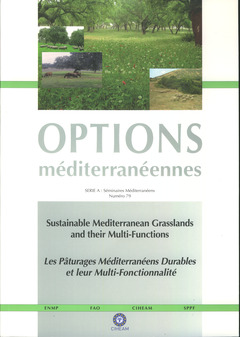Description
Sustainable Mediterranean Grasslands and their Multi-Functions... (Options méditerranéennes série A N° 79 2008) Bilingue
Authors: PORQUEDDU C., TAVARES DE SOUSA M.M
Language: English, French
Subject for Sustainable Mediterranean Grasslands and their...:
Approximative price 83.85 €
Subject to availability at the publisher.
Add to cart
Publication date: 05-2008
500 p. · 21x30 cm · Paperback
500 p. · 21x30 cm · Paperback
Description
/li>
The meetings of the Sub-network on Mediterranean Forage Resources within the FAO-CIHEAM Inter-Regional Cooperative Research and Development Network on Pasture and Fodder Crops represent the only specific opportunity for researchers working on Mediterranean grasslands and rangelands coming from the Mediterranean Basin and other Mediterranean regions of the world to analyse the related current advances. Sustainable Mediterranean grasslands and their multi-functions was the suggested and approved theme for the 12th Meeting of the Sub-network on Mediterranean Forage Resources, held in Elvas (Portugal) from 9 to 12 April 2008. The main function ot managed grasslands is the production of forage for ruminants but grasslands support commodity production and environmental, economic and social functions beyond the farm context. These externalities include the maintenance of biodiversity and landscape, soil, air and water quality, recreation, rural employment and social benefits. There are complex interactions and conflicts between these various functions e.g. grasslands for production of renewable energy. The potential of this land use form is therefore related to grassland performance in all its possible functions at each site. There is a growing interest in farming systems that serve multiple purposes, in the context of driving forces such as environmental concerns, climate change, etc. This places a demand on research approaches and methodologies that enable analysis of current farming systems and identification of new grassland systems integrated with landscape, environmental and recreational purposes, in a multiple land-use view. It should not be forgotten that traditional grassland-based agro-pastoral systenis have developed over millennia often using different species and ingenious combinations ot management practices representing a cultural heritage. On the above subject, this volume contain 93 contributions presented in the Meeting, providing useful up-to-date information about the multi-functional role of grassland systems, the role of perennial grasses in rainfed farming systems, the eco-physiological strategies to overcome water deficit and the selection for sustainable forage crops and pastures, on traditional or newly domesticated species, facing climatic changes
© 2024 LAVOISIER S.A.S.

